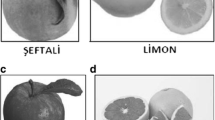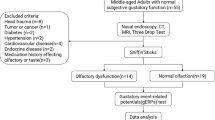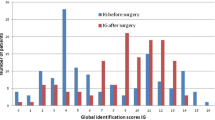Abstract
The objective of this study was to reduce the recording duration of chemosensory event-related potentials (CSERP) and thereby to make the method more suitable for routine clinical use. Measurements were performed in the Department of Otorhinolaryngology of the university hospital of Cologne. Two protocols with different sequences [inter-stimulus intervals (ISI)-standard sequence: 30 s; PRS-15: pseudo-randomized sequence, mean ISI of 15 s] were applied to 40 volunteers to record CSERPs. To compare CSERP recordings under optimal and adverse test conditions, 20 younger/normosmic adults and 20 older/hyposmic participants were included in this study. Olfactory function was gauged using the “Sniffin’Sticks” test. For CSERP recordings, phenylethyl alcohol, hydrogen sulfide and carbon dioxide were used for olfactory or trigeminal stimulation, respectively. Both ISI protocols allowed recording CSERPs under optimal and adverse test conditions and distinguishing both groups by latencies (p ≤ 0.015). The time requirement for the recording of CSERPs with the PRS-15 sequence was less than 30 min. The pseudo-randomized sequence allowed the recording of diagnostically conclusive CSERPs in both groups and saved approximately 40% of the measuring time. This seems to be especially useful in cases where a yes/no answer (e.g., medical reports, exclusion of anosmia) is required. Shortening the time requirement significantly allows applying CSERPs to larger populations of patients with olfactory impairment.


Similar content being viewed by others
References
Hummel T, Sekinger B, Wolf SR, Pauli E, Kobal G (1997) Sniffin’ Sticks: olfactory performance assessed by the combined testing of odor identification, odor discrimination and olfactory threshold. Chem Senses 22:39–52
Hummel T, Kobal G, Gudziol H, Mackay-Sim A (2007) Normative data for the “Sniffin’ Sticks” including tests of odor identification, odor discrimination, and olfactory thresholds: an upgrade based on a group of more than 3,000 subjects. Eur Arch Otorhinolaryngol 264:237–243
Kobal G (1981) Elektrophysiologische untersuchungen des menschlichen geruchssinns. Georg Thieme Verlag, Stuttgart
Hummel T, Kobal G (2001) Olfactory event-related potentials. In: Simon SA, Nicolelis MAL (eds) Methods and frontiers in chemosensory research. CRC, Florida, pp 429–464
Kassab A, Schaub F, Vent J, Huttenbrink KB, Damm M (2009) Effects of short inter-stimulus intervals on olfactory and trigeminal event-related potentials. Acta Otolaryngol 129:1250–1256
Huart C, Eloy P, Collet S, Rombaux P (2011) Chemosensory function assessed with psychophysical testing and event-related potentials in patients with atrophic rhinitis Eur Arch Otorhinolaryngol
Tateyama T, Hummel T, Roscher S, Post H, Kobal G (1998) Relation of olfactory event-related potentials to changes in stimulus concentration. Electroencephalogr Clin Neurophysiol 108:449–455
Boesveldt S, Haehner A, Berendse HW, Hummel T (2007) Signal-to-noise ratio of chemosensory event-related potentials. Clin Neurophysiol 118:690–695
Scheibe M, Opatz O, Hummel T (2009) Are there sex-related differences in responses to repetitive olfactory/trigeminal stimuli? Eur Arch Otorhinolaryngol 266:1323–1326
Covington JW, Polich J (1996) P300, stimulus intensity, and modality. Electroencephalogr Clin Neurophysiol 100:579–584
Hawkes CH, Shephard BC, Daniel SE (1997) Olfactory dysfunction in Parkinson’s disease. J Neurol Neurosurg Psychiatry 62:436–446
Hummel T, Barz S, Pauli E, Kobal G (1998) Chemosensory event-related potentials change with age. Electroencephalogr Clin Neurophysiol 108:208–217
Livermore A, Hummel T (2004) The influence of training on chemosensory event-related potentials and interactions between the olfactory and trigeminal systems. Chem Senses 29:41–51
Krauel K, Pause BM, Sojka B, Schott P, Ferstl R (1998) Attentional modulation of central odor processing. Chem Senses 23:423–432
Acknowledgments
We have no actual or potential conflict of interest in relation to this paper.
Author information
Authors and Affiliations
Corresponding author
Electronic supplementary material
Below is the link to the electronic supplementary material.
Rights and permissions
About this article
Cite this article
Schaub, F., Damm, M. A time-saving method for recording chemosensory event-related potentials. Eur Arch Otorhinolaryngol 269, 2209–2217 (2012). https://doi.org/10.1007/s00405-011-1921-3
Received:
Accepted:
Published:
Issue Date:
DOI: https://doi.org/10.1007/s00405-011-1921-3




